

About Hyperbaric Oxygen Treatments (HBOT)
Supporting documents (classified chronologically)

Editor: Daniel Mathieu
This Handbook is intended as a reference document for
researchers and clinicians alike to be used both in the
research laboratory and in everyday hyperbaric clinical
practice; it also provides support material for teachers.
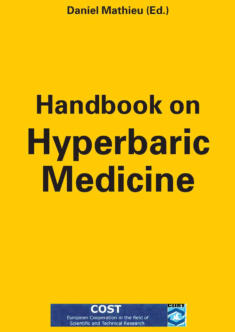

Authors: F. K. Butler, C. Hagan, H. Murphy-Lavoie
This paper is a review of HBOT (Hyperbaric Oxygen
Treatment) for ocular indications.
Because some ocular disorders require rapid
administration of HBOT to restore vision, patients with
acute vision loss should be considered emergent when
they present. Visual acuity should be checked
immediately.
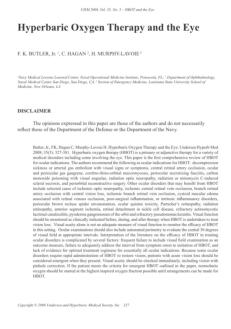

Author: Stephen R. Thom
This review aims to outline advances addressing the
role that reactive species of oxygen and nitrogen play
in the therapeutic mechanisms of hyperbaric oxygen.
The study will be organized around major categories
of problems or processes where controlled clinical trials
have demonstrated clinical efficacy for hyperbaric
oxygen therapy. Reactive species are now recognized
to play a major role in cell signal
transduction cascades, and the discussion will focus on
how hyperbaric oxygen acts through these pathways
to mediate wound healing and ameliorate
postischemic and inflammatory injuries.
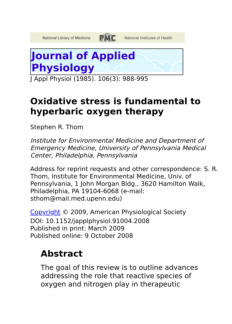

Publisher: Undersea and Hyperbaric Medical Society
This document from the Undersea and Hyperbaric
Medical Society , published in 2014, provides guidance
and support for scientists and practitioners of hyperbaric
oxygen therapy.
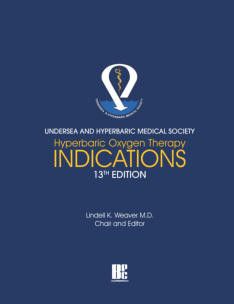

Authors:
Daniel Mathieu, Alessandro Marroni and Jacek Kot
The tenth European Consensus Conference on
Hyperbaric Medicine took place in April 2016,
attended by a large delegation of experts from
Europe and elsewhere. The focus of the
meeting was the revision of the European
Committee on Hyperbaric Medicine (ECHM) list
of accepted indications for hyperbaric oxygen
treatment (HBOT), based on a thorough review
of the best available research and evidence-
based medicine (EBM)
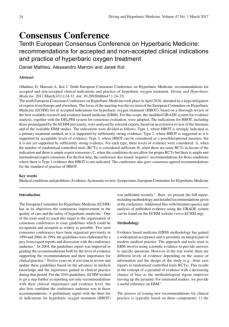

Authors: Joe KS Leung, Rex PK Lam
Hyperbaric oxygen therapy is widely accepted as a life-
saving treatment for decompression illness.
Yet, its use in acute carbon monoxide poisoning has
remained controversial because of inconsistent
findings in clinical trials. Hyperbaric oxygen therapy has
an adjunctive role in managing gas gangrene,
necrotising soft-tissue infection, and crush injury, as
supported by the case series. Several cases have been
reported in the literature detailing the use of
hyperbaric oxygen therapy in patients with severe
anemia in whom blood transfusion is not possible.
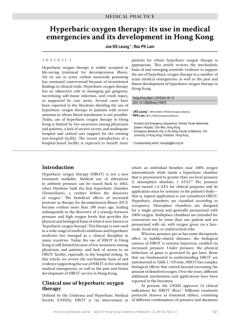

Authors: Ali Erdal Gunes, Samil Aktas.
Complete blood count (CBC) is a routine diagnostic
procedure for patients and a part of routine health
inspection for healthy individuals. The effect of
hyperbaric oxygen (HBO2) therapy on CBC is not
known.
The objective of this study was to determine the effects
of HBO2 on blood parameters in CBC with long-term
HBO2 therapy.
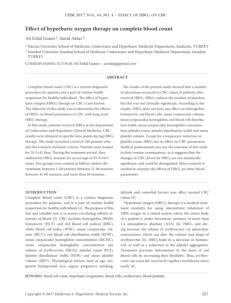

Authors:
Amir Hadanny, Tal Zubari, Liat Tamir-Adler, Yair Bechor,
Gregory Fishlev, Erez Lang, Nir Polak, Jacob Bergan,
Mony Friedman, and Shai Efrati
The aim of this study was to evaluate the effect of
hyperbaric oxygen therapy (HBOT) on pulmonary
functions of patients receiving the currently used
HBOT protocol.
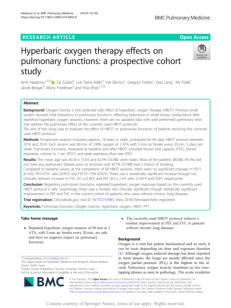

Authors:
Jonathan L. Halbach, James M. Prieto, Andrew W.
Wang, Dennis Hawisher, David M. Cauvi, Tony Reyes,
Jonathan Okerblom, Israel Ramirez-Sanchez, Francisco
Villarreal, Hemal H. Patel, Stephen W. Bickler, George
A. Perdrizet, and Antonio De Maio.
Sepsis is a major clinical challenge, with therapy limited
to supportive interventions. Therefore, the
search for novel remedial approaches is of great
importance.
The authors addressed whether hyperbaric oxygen
therapy (HBOT) could improve the outcome of
sepsis using an acute experimental mouse
model.
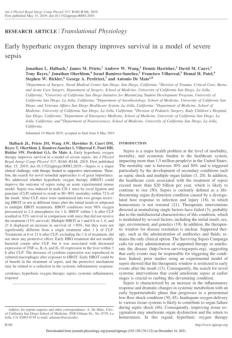

Author: Tahreem Fatima
This article does not speak of diving but on the use of
Hyperbaric oxygen therapy (HBOT) as a primary
emergency treatment in some acute
pathologies or alternative therapies, particularly
in deep and chronic infections such as
necrotizing fasciitis, osteomyelitis, chronic
soft tissue infections, and infective endocarditis for
chronic long-term pathologies.
Teams equipped with chambers should be informed
that they can be used in case of such
pathologies are found on the worksite.
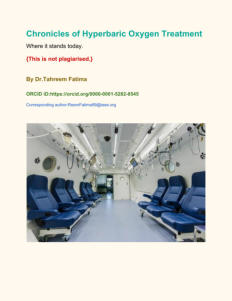

Authors:
Babak Hajhosseini, Britta A. Kuehlmann, Clark A.
Bonham, Kathryn J. Kamperman, Geoffrey C. Gurtner
As suggested in the title, this document reviews the
various technics used for Hyperbaric Oxygen
therapy. It can be used as a complementary
source of information regarding the positive use
of hyperbaric oxygen.
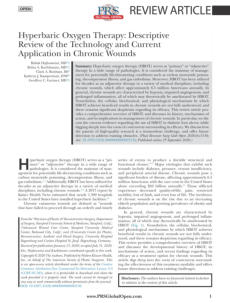

Authors:
Adam E Howard, Peter Buzzacott, Ian C Gawthrope,
Neil D Banham
Middle ear barotrauma (MEBt) is a common side effect
of hyperbaric oxygen treatment (HBOT) and
can result in pain, hearing loss, tinnitus, and
otorrhagia. The use of
antiplatelet/anticoagulant drugs is thought to
increase the risk and severity of MEBt during
HBOT.
The authors studied all patients treated with HBOT
over four years (between 01 January 2015 to
31 December 2018), looking at the incidence of
MEBt and the concurrent use of antiplatelet
and/or anticoagulant drugs.
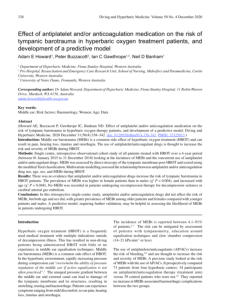

Authors:
Anna B. Marcinkowska, Natalia D. Mankowska,
Jacek Kot, Pawel J. Winklewski.
Hyperbaric oxygen therapy (HBOT) is a modality of
treatment in which patients inhale 100%
oxygen inside a hyperbaric chamber pressurised
to greater than 1 atmosphere. The aim of this
review is to discuss neuropsychological findings
in various neurological disorders treated with
HBOT and to open new perspectives for
therapeutic improvement.
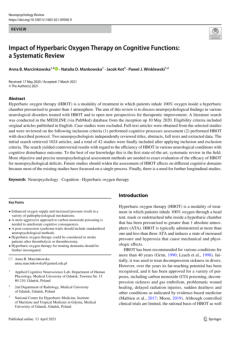

Authors:
Rutger C Lalieu, Ida Akkerman, Peter-Jan AM van Ooij,
Annieke A Boersma-Voogd, Rob A van Huls
Due to the global rise of obesity, the role of nutrition
has gathered more attention. Paradoxically, even
overweight persons may be malnourished. This may
delay wound healing or recovery of late radiation
tissue injury (LRTI).
Hyperbaric oxygen treatment (HBOT) is used to
improve wound healing or LRTI complaints. The aim of
this study was to assess the dietary intake levels of
nutrients important for recovery in patients referred for
HBOT.
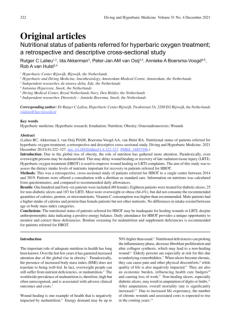

Authors:
Khodor Haidar Hassan, Joelle Azzi, Gian Marco Oppo,
Hadi Raef Rida, Roberto Vecchioni, Mohamad Ali
Chahrour, Mehdi Raef Rida, Fadel Nahle, Hadi Farhat,
Edwin Parra Prada, and Ahmad Najib Ballout.
Hyperbaric Oxygen Therapy (HBOT) is a
recommended treatment for all hypoxic pathologies
and has been used for decades as a recommended
treatment for hypoxic-ischemic and infectious
disorders.
The pressures utilized vary from 2.2 to 2.8 ATA. 20
Osteoporosis patients treated underwent HBOT at 1.5
ATA and 100% oxygen for 15 sessions.
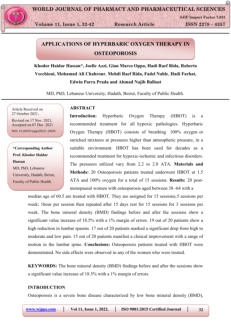

Author: Paul G. Harch
This paper is a systematic review of hyperbaric oxygen
therapy (HBOT) in Persistent Postconcussion
Syndrome, a condition with significant consequences
and limited treatment options, using a dose-analysis
based on the scientific definition of hyperbaric oxygen
therapy as a dual-component drug composed of
increased barometric pressure and hyperoxia.
This document is not directly linked to diving.
However, it allows for a better understanding of the
properties of oxygen and its potential usage in the
treatment of injuries.
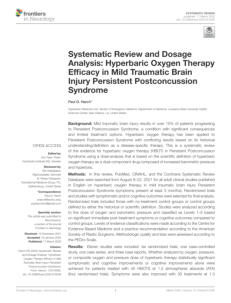

Authors:
Gordon Slater, Martin O’Malley, Tayla Slater, and
Tandose Sambo.
Hyperbaric Oxygen Therapy (HBOT) has been a
recognized treatment for a multitude of injuries for
decades and presents significant opportunities for the
improvement of wound healing, blood vessel
restoration, reduction in recovery time after surgery,
treatment of neurological and neurodegenerative
disorders, improvement of memory and cognition,
sports injury rehabilitation, cartilage regeneration, and
overall quality of life. This paper investigates HBOT and
its indications for use.
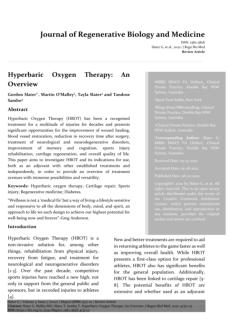


Click on the
octopus to return to
the top of the page
The beneficial properties of hyperbaric oxygen are used for
purposes other than reducing decompression times and solving
diving-related accidents or gasses intoxications, and many
scientists highlight the beneficial results of such treatments. It is,
for example, the case of a paper called “Hyperbaric Oxygen
Therapy: An Overview”, written by doctors Gordon Slater, Martin
O’Malley, Tayla Slater, and Tandose Sambo.
In another article called “Chronicles of hyperbaric oxygen
treatment”, doctor Tahreem Fatima suggests that such therapies
enhance the anti-microbial effects of the immune system and have
an additive or synergistic effect with anti-microbial agents.
In their paper entitled “Hyperbaric Oxygen Therapy: Descriptive
review of the technology and current application in chronic wounds”,
doctors Babak Hajhosseini, Britta A. Kuehlmann, Clark A. Bonham,
Kathryn J. Kamperman, & Geoffrey C. Gurtner, make an
assessment of the hyperbaric oxygen treatments approved by the
Undersea and Hyperbaric Medical Society (UHMS). The
acknowledged applications of these procedures other than
resolving decompression sickness, arterial gas embolisms, and CO
poisoning intoxications can be listed as follows:
•
Gas gangrene
•
Acute traumatic peripheral ischemia
•
Crush injuries and suturing of severed limbs
•
Acute peripheral arterial insufficiency
•
Progressive necrotizing infections
•
Preparation and preservation of compromised skin grafts
•
Chronic refractory osteomyelitis
•
Radionecrosis
•
Cyanide poisoning
•
Actinomycosis
•
Diabetic wounds of the lower extremities
•
Failure of standard wound therapy
•
Osteoporosis
Note that some hospitals’ hyperbaric treatment chambers differ
from those used for diving activities by the fact that they are
square instead of rounded for better integration in the building and
easy access by people not in optimal physical condition. These
chambers are heavier than those we use for diving due to the
necessity to compensate for the non-optimal shape for
withstanding the pressure (rounded shapes are the most resistant),
and they are usually unable to withstand the same pressures as
rounded chambers. For example, the model below designed by CCC
Group (https://www.cccgroupinc.com/), a company based in San
Antonio, Texas, USA, is limited to three ATA.
Some other hospital chambers are rounded, except for the
extremities that are flat and provided with a square door, like
chambers used for tunneling. These chambers are very wide
compared with those we use for surface-supplied and saturation
diving; it is the case of the model below.
Of course, diving chambers can be used for such medical
treatments, and doctors may request to use them if hospital
facilities are not available and, by this fact, involve their operators.
Documents are available in our database to provide more
information regarding this aspect of using hyperbaric chambers.
Click on the button below to open the page where they are described
with the hyperlinks to open and download them.
They can also be accessed through Documents / Scientific papers.
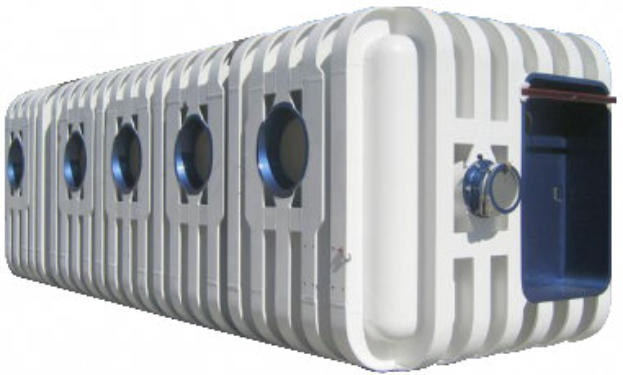
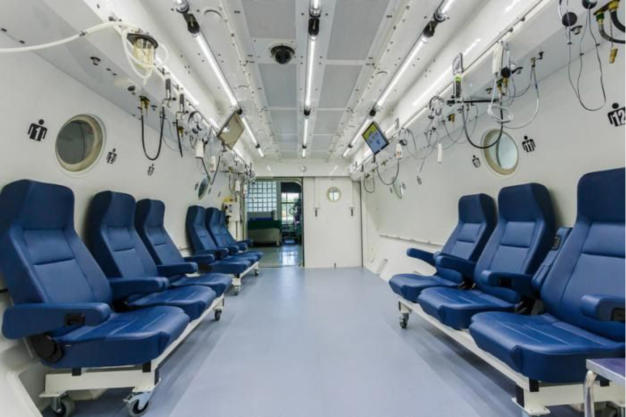
Photo from “Chronicles of hyperbaric oxygen treatment” by doctor Tahreem Fatima












